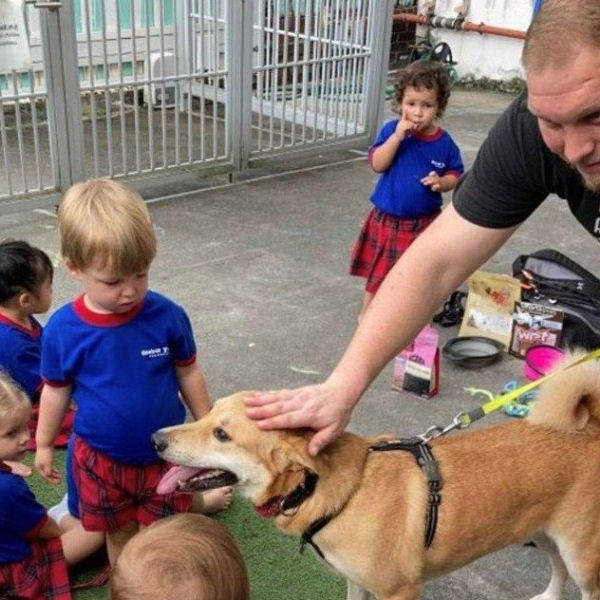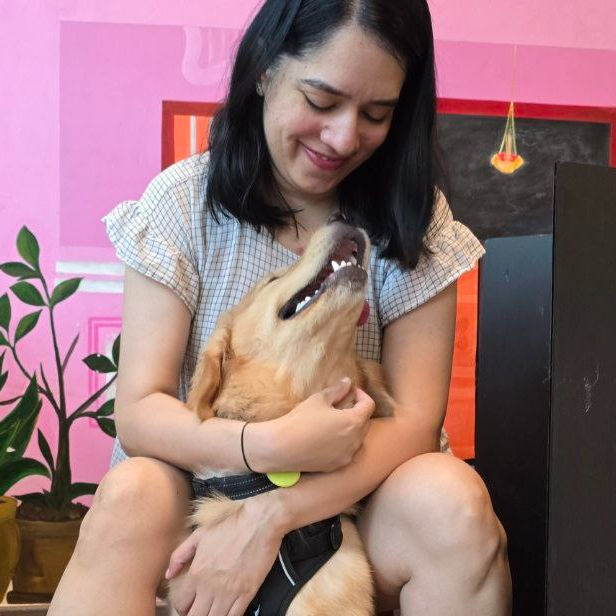Keeping Your Toddler Safe Around Your Dog: A Daddy’s Guide
- Fraser Noble

- Aug 25
- 5 min read

Being a parent and a dog dad is one of the most rewarding, exhausting, and sometimes nerve-wracking roles you can have. Add in a home with toddlers and rescue dogs, and it can feel like a balancing act on a tightrope. I know this first-hand—I’m Fraser, father to a spirited four-year-old, and the caretaker of three rescue dogs, Athos, Aramis, and Porthos. I’m also a professional dog trainer and behaviour consultant, which gives me both the insight and the practical tools to keep everyone safe.
Toddlers are unpredictable, loud, and fast-moving, which is exactly what can stress even the most well-behaved dogs. Rescue dogs can carry baggage from past experiences, making it even more essential to approach interactions with care. Over the years, I’ve seen what works—and what doesn’t. Here’s a comprehensive guide for families looking to create a safe, happy home where toddlers and dogs coexist harmoniously.
1. Understand the Dog-Toddler Dynamic
Dogs read the world very differently from humans. For them, sudden movements, high-pitched squeals, or repeated chasing can be stressful or threatening. Toddlers, on the other hand, are exploring, learning, and naturally energetic—they aren’t aware of the signals they may be sending.
Early stress signs in dogs include:
Stiff or frozen posture
Lip licking, yawning, or paw lifts
Turning away, moving off, or hiding
Growling, barking, or snapping
Avoiding eye contact or locking eyes in fear Learn more on this here: https://www.noble-canine.com/post/introduction-to-calming-signals
Why it matters: These aren’t “bad behaviours”—they’re communication. Dogs are giving you a warning: “I need space.” If these signs are ignored, the dog may escalate to a bite or snap, which is almost always preventable with early intervention.
2. Supervision Is Non-Negotiable

I cannot emphasise this enough: never leave a toddler alone with a dog. Not even for a minute. Even the calmest dog can be triggered by the sudden actions of a small child. Supervision doesn’t just mean being in the same room—it means being actively aware of both the child and the dog.
Practical tips from my home:
Always stay at eye-level with your toddler during dog interactions.
Keep a hand near your dog, ready to redirect if necessary.
Separate dogs and toddlers during high-energy play.
Make interactions structured rather than chaotic—toddlers can’t yet understand “be gentle” in the middle of a squeal-fest.
3. Create Safe Spaces for Your Dogs

Rescue dogs and sensitive dogs need a retreat—somewhere they can decompress and feel safe. At our home, each of my dogs has their own space with their bed, toys, and water, away from the chaos of toddler activity.
How to set up a safe space:
Choose a quiet room, corner, or gated-off area.
Make it toddler-proof—gates work well if the dog is small enough to jump over.
Include enrichment: chews, food puzzles, and soft bedding.
Train your dog to understand that this is a positive space, not punishment.
Daddy tip: Reward your dog when they go to their safe space voluntarily. This reinforces that choosing calm over chaos is okay.
4. Teach Your Toddler Gentle Interaction

Toddlers can learn the basics of dog safety earlier than we think. Start with very simple rules that are consistent and repetitive:
No grabbing, hugging tightly, or pulling ears and tails
No chasing, cornering, or crowding the dog
Gentle strokes, soft voices, and calm movements
Respect when the dog retreats or shows stress
How I teach this: We practice with stuffed toys before real interactions, role-playing how to “ask” the dog for a pat or how to respect the dog’s boundaries. Positive reinforcement works here too—praise the toddler for calm, careful behaviour.
5. Gradual Desensitisation for the Dog

Dogs can learn to tolerate—or even enjoy—toddler activity if introduced correctly. This isn’t about forcing interaction; it’s about gradual, positive exposure.
Step-by-step approach:
Start with recorded toddler sounds (crying, squealing, running) at a very low volume.
Pair sounds with treats or toys your dog loves.
Slowly increase volume or proximity, only if the dog remains relaxed.
Reward calm behaviour consistently.
Pro tip: Never force a dog to interact. Let them control the distance. Over time, dogs start associating toddler sounds with good things, rather than stress or fear.
6. Predictable Routines Reduce Stress
Dogs, especially rescue dogs, thrive on structure. Sudden chaos can trigger stress, so predictable routines help both dogs and toddlers feel safe.
Example from our home:
Dog walks happen at the same time each day.
Meals and playtime have consistent schedules.
Calm cues like “place” or “settle” are used to guide the dog during toddler play and meal times.
This predictability builds confidence in the dog and teaches toddlers that calm interaction is the standard.
7. Practical Management Tools
Even with training, management tools are essential for toddler safety and dog confidence. Think of them as insurance.
Effective tools include:
Baby gates or exercise pens: Keep toddlers and dogs separated during high-energy times.
Crates: Although not essential, in many cases crates properly introduced, crates can become a safe haven for dogs.
Leash or tether during initial introductions: Gives you control if stress escalates.
Environmental enrichment: Keep the dog occupied with chews, toys, or food puzzles while toddlers play.
Management is not a punishment—it’s a preventative measure that protects both child and dog.
8. Recognise When Professional Help Is Needed

Some behaviours can be tricky to manage alone, especially with rescue dogs:
Repeated growling or snapping
Severe fear of toddler movement or sounds
Aggression escalating despite supervision
A professional behaviour consultant can create a structured plan, including:
Trigger identification and avoidance strategies
Behaviour modification through positive reinforcement and BAT (Behaviour Adjustment Training)
Training routines that gradually increase dog-toddler tolerance
If you feel that you are in need of aversive tools, using discomfort, force, or pain to control the dogs behaviour, you need a professional. If your current professional is at this stage, you need a professional with a higher level of knowledge.
Early intervention prevents incidents and gives families confidence that both children and dogs are safe.
9. Real-Life Daddy Tips From My Home
Always celebrate small wins: a dog remaining calm while your child walks by is progress.
Keep high-value treats handy for both dog and toddler moments.
Model calm behaviour yourself—dogs read your energy as much as your child’s.
Never underestimate the power of “time-outs” for both dogs and toddlers. Everyone needs a break.
Rotate toys and enrichment to keep dogs engaged, reducing the chance of tension.
10. Key Takeaways
Supervision is essential—never leave toddlers alone with dogs.
Safe spaces give dogs a place to decompress.
Teach toddlers gentle, respectful interaction early.
Gradually desensitise dogs to toddler sounds and movement.
Use predictable routines to reduce stress for everyone.
Management tools like gates, crates, and enrichment are practical safety measures.
Seek professional guidance if stress or aggression escalates.

Being a parent and a dog dad isn’t easy, sometimes it is simply exhausting—but it’s incredibly rewarding. With the right tools, preparation, and understanding, your home can be a safe, happy environment for toddlers and dogs alike. Even though I do this for a living, my home is not perfect, chaos happens, my daughter may have a melt down and scare the dogs, the dogs might be playing too rough together and she gets excited and tries to join in getting a heavy paw on the foot in the process. These things happen. The best we can do as parents and pawrents is be as aware as we can, and follow the structure and guidance to make our homes as safe as possible.
%202_JPG.jpg)



Comments